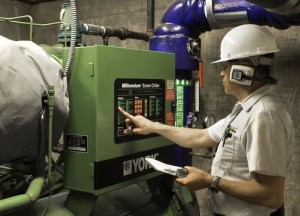
An Energy Management System (EMS) helps reduce utility costs by as much as 30% through enterprise visibility and control over HVAC, lighting, and other facility assets.
When profit margins are razor thin, it can be easy to write off something as seemingly unimportant as heating and air conditioning maintenance. Why spend money on something that seems to be working perfectly, right? Well, what if we told you that HVAC systems in commercial buildings are responsible for more than 40% of total energy? HVAC equipment loses 5% of its overall efficiency every year it operates without maintenance, causing your energy bill to steadily climb. Suddenly, it is costing you more to simply run your HVAC equipment than it would have with regular, preventive maintenance. So, instead of slashing your HVAC maintenance budget, why not find a way to better manage costs?
Be Proactive with An Energy Management System (EMS)
An Energy Management System (EMS) helps reduce utility costs by as much as 30% through enterprise visibility and control over HVAC, lighting, and other facility assets. This newfound level of control allows business owners and property managers to better track energy usage, implement solutions to improve energy efficiency, set baseline numbers to track those improvements, and ultimately reduce utility costs and your overall facility maintenance budget.
Armed with actionable data from the Energy Management System, a business can improve productivity and delivers greater energy savings by:
- Identify maintenance issues as they occur
- Verify that service providers are performing necessary maintenance
- Prevent unnecessary service calls
- Reduce costly downtime
- Maximize kWh savings
Facilities that implement an HVAC preventive maintenance program use 15-20% less energy than those without it.
Several Processes to Further Reduce HVAC Maintenance Costs
- Fault Detection & Diagnosis or, FDD: Remote detection of performance degradation can help catch issues early and minimize costly repairs. According to a California Energy Commission study approximately 35% of U.S. small commercial package rooftop HVAC units are broken and not functioning efficiently. Odds are that if your commercial building has multiple RTUs and you have not had them serviced recently, at least one is not working properly. As a result, the others will overcompensate, driving energy and HVAC maintenance costs upward.
- Remote Access: HVAC issues do not occur on a 9-5 schedule. Unfortunately, this means things can go wrong when you are not around. More importantly, they can go wrong and go unnoticed for hours or even days. So it is important to be able to access your EMS remotely to detect issues, as well as perform a remote shutdown/reset of the HVAC equipment so that it does not continue to waste energy and wear out other mechanical parts.
- Repair and Maintenance Validation: An Energy Management Systemallows business owners and property managers to verify that service providers are performing necessary maintenance before they leave the job site.
- Prioritize Repairs: What requires your immediate attention? What can wait until your next appointment? Having an EMS in place will allow you to better prioritize repairs and manage your HVAC maintenance budget.
Invest in an Energy Management System and Get Control Over Your Heating and Air Conditioning Budget
Crockett Facilities Services, Inc. (CFSI) is committed to helping building owners, property managers, engineers and facility professionals lower their operating expenses through HVAC preventive maintenance. We develop cost-effective, customized preventive maintenance plans for commercial buildings that will provide you with peace of mind, improve comfort, save you money, and protect your capital investment.
Click Here to Request a Quote
CFSI also offers 24/7 emergency HVAC repairs, retrofits, installations, and equipment replacement, with both on-site engineering services and mobile HVAC service.
To learn more about the benefits of an Energy Management System, please contact us at 202.600.2787 or sales@crockett-facilities.com.
Like us on Facebook; follow us on LinkedIn, Twitter, and Google+.
Sources:
Regain control of the HVAC repair budget: Save on energy costs; improve productivity and asset life.
